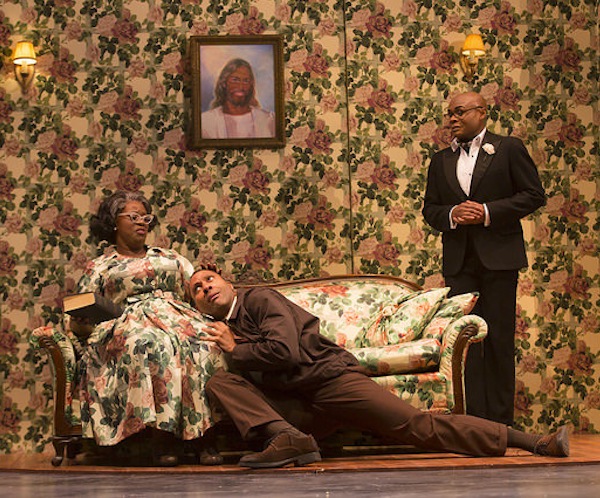Theater Review: “The Colored Museum” — Raucous, Riveting, But Out of Sync
George C. Wolfe’s 1986 collection of vignettes that spoof and celebrate black stereotypes occasionally plays like reruns from the ’90s TV show In Living Color and at other times feels more disturbing than amusing.
The Colored Museum by George C. Wolfe. Directed by Billy Porter. Staged by the Huntington Theatre Company at the Boston University Theatre, Boston, MA, through April 5.

Capathia Jenkins, Ken Robinson, and Nathan Lee Graham in the HTC production of The Colored Museum. Photo by T. Charles Erickson.
By Terry Byrne
Nearly 30 years after the debut of The Colored Museum, this raucous and riveting look at black culture feels oddly dated. The Huntington Theatre Company production has the advantage of some passionate performances by an ensemble of Broadway A-listers, fluid direction from award-winning performer Billy Porter and an evocative and flexible set by Clint Ramos. But George C. Wolfe’s collection of vignettes that spoof and celebrate black stereotypes occasionally plays like reruns from the ’90s TV show In Living Color and at other times feels more disturbing than humorous.
In a climate in which the phrase “black lives matter” is one people feel compelled to say out loud because reality appears to contradict it, the staging is driven more by a sense of anger than amusement. Of course, “The Photo Session,” “The Hairpiece” and “Lala’s Opening” are hilarious sendups of what it means to be black and fabulous, but the most memorable moments in this Colored Museum occur in between the laughs, when the characters talk about rage and pain. In “Cookin’ with Aunt Ethel” we are encouraged to believe that “rage congeals and turns to jazz”; in “A Soldier with a Secret” there is only one way to release his brothers from their pain; and in “The Gospel According to Miss Roj,” the drag queen defiantly announces “we don’t ask for acceptance.”
Local percussionist Akili Jamal Haynes has been added (by Porter) to provide a rhythmic heartbeat, creating visceral transitions between the scenes and links among the characters. The director also skillfully finds ways to use movement and choreography to connect the characters to the action. Yet the audience remains at arm’s length. In an effort to bring the viewers closer, Porter and musical director and arranger James Sampliner have updated some of the musical themes, but their work is an overlay on an already existing template and it doesn’t go far enough.
Fortunately, Porter has gathered an outstanding ensemble of singer/actors who tear the roof off the theater with their vocal prowess and when given the opportunity make us squirm with the conviction of their emotionally raw performances. From the haunting, heartbreaking a cappella snippet of “My Girl” to the full out “all black musical” and Lala’s operatic diva performance, Nathan Lee Graham, Capathia Jenkins, Ken Robinson, Shayna Small, and Rema Webb deliver Wolfe’s archetypal characters with an energy and immediacy that is hard to resist.
While creator Wolfe embraced the emotional contradictions inherent in American black culture, the current social atmosphere exposes the tragic difficulty of reconciling those differences in the political, economic, and legal realms. The strength of this production lies in Porter’s willingness to push the moments of darker, more painful truths to the forefront, even if that leaves the comic moments oddly out of synch with what is going on today.
Terry Byrne has been writing about the arts for nearly two decades. She has an MFA in Playwriting from Boston University and is a Resident Scholar at Brandeis University’s Women’s Studies Research Center.
Tagged: Billy Porter, George C. Wolfe, Huntington-Theatre-Company

I have not seen the HTC production. I readily accept what Terry writes about the high caliber of the staging and performances. But a serious theater critic in 2015 must ask an elemental question: why do our professional theaters have go back thirty years to find a play that explores race relations in America? Have no playwrights written something of value about what is going on in our country on this issue since 2005? What are our theaters afraid of?
Here is a modest proposal: the Justice Department’s civil rights investigation of Ferguson, MO revealed a powerful and dramatic picture of systematic municipal corruption: the economic exploitation of the black community by police, judges, lawyers, and city government. Send a dramatist to some of Boston’s marginalized neighborhoods and have him or her interview the residents, the police, politicians, and judges about these issues — their stories and conflicting points of view could generate a play about what is going on around us. The injustice uncovered in Ferguson is not unique … let’s see it dramatized on stage.
Good for you, Editor Marx. Hopefully, those dramatists are already out there and we will see the results on stage in a season or so. Such a story line would probably encompass class relations as well. Although the initial core of the story has been racial violence, it also served to expose the “systemic municipal corruption” of the powers that be. Shakedowns, forfeitures, seizure of cash and property and so on, whose principal victims have been the poor, which include a disproportionately large number of people of color.